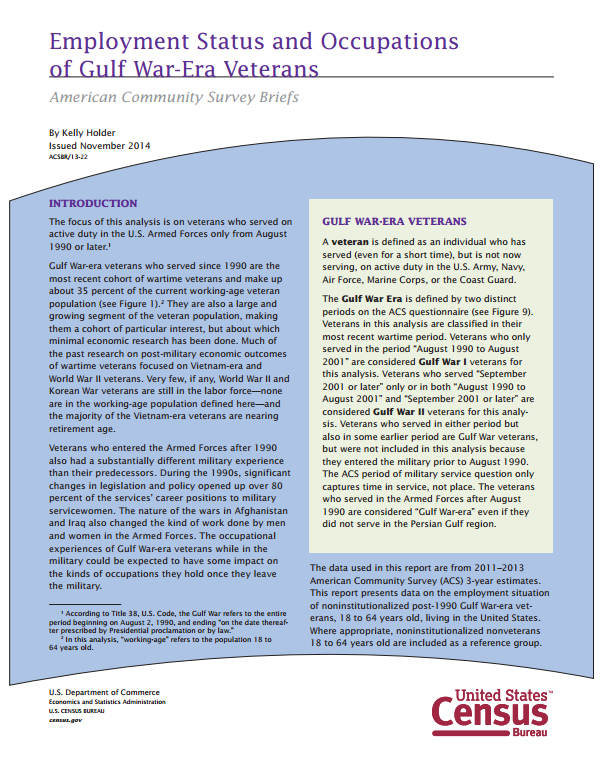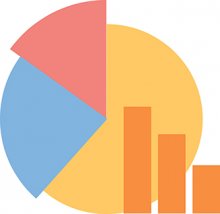By the Numbers - Dec. 1, 2014
35%
The percentage of the "current working-age veteran population" who served since 1990, according to a new report from the U.S. Census Bureau -- The Employment Status and Occupations of Gulf War-Era Veterans.
This report, which covers the time period 2011-2013, takes a look at the employment status of "Gulf War I" veterans (who served between August 1990 to August 2001) and "Gulf War II" veterans (those who served from September 2001 or later, or who served in both periods.) The Census Bureau defines "working age" as 18-64. Among the report's findings:
- Men and women veterans from both Gulf War eras were more likely to be employed in full-time, year-round jobs than their nonveteran counterparts.
- Management occupations were the largest group for Gulf War I veteran men (12.1 percent) and nonveteran men (13.3 percent).
- The largest occupation group for Gulf War II veteran men was protective service occupations (13.2 percent).
- The largest occupation group for all women, veteran and nonveteran, was office and administrative support occupations.
- About 17 percent of women veterans from both Gulf Wars worked in health care practitioners and technical occupations, compared with about 10 percent of nonveteran women.
- About 5 percent of women veterans from both Gulf War eras worked in protective service occupations, compared with about 1 percent of nonveteran women.
- More Gulf War I and Gulf War II veteran women who were employed full time, year-round worked in STEM occupations (about 6 percent each) than nonveteran women (about 4 percent).
- A higher percentage of Gulf War I veteran men who worked full time, year-round were employed in STEM occupations (11.5 percent), compared with Gulf War II veteran men (10.3 percent) and nonveterans (9.5 percent).
In 2013, according to the Bureau of Labor Statistics, the unemployment rates for male and female Gulf War-era I veterans were 5.7 percent and 5.3 percent, respectively, lower than the rates for their Gulf War-era II veteran counterparts (8.8 percent and 9.6 percent, respectively).

35%
The percentage of the "current working-age veteran population" who served since 1990, according to a new report from the U.S. Census Bureau -- The Employment Status and Occupations of Gulf War-Era Veterans.
This report, which covers the time period 2011-2013, takes a look at the employment status of "Gulf War I" veterans (who served between August 1990 to August 2001) and "Gulf War II" veterans (those who served from September 2001 or later, or who served in both periods.) The Census Bureau defines "working age" as 18-64. Among the report's findings:
- Men and women veterans from both Gulf War eras were more likely to be employed in full-time, year-round jobs than their nonveteran counterparts.
- Management occupations were the largest group for Gulf War I veteran men (12.1 percent) and nonveteran men (13.3 percent).
- The largest occupation group for Gulf War II veteran men was protective service occupations (13.2 percent).
- The largest occupation group for all women, veteran and nonveteran, was office and administrative support occupations.
- About 17 percent of women veterans from both Gulf Wars worked in health care practitioners and technical occupations, compared with about 10 percent of nonveteran women.
- About 5 percent of women veterans from both Gulf War eras worked in protective service occupations, compared with about 1 percent of nonveteran women.
- More Gulf War I and Gulf War II veteran women who were employed full time, year-round worked in STEM occupations (about 6 percent each) than nonveteran women (about 4 percent).
- A higher percentage of Gulf War I veteran men who worked full time, year-round were employed in STEM occupations (11.5 percent), compared with Gulf War II veteran men (10.3 percent) and nonveterans (9.5 percent).
In 2013, according to the Bureau of Labor Statistics, the unemployment rates for male and female Gulf War-era I veterans were 5.7 percent and 5.3 percent, respectively, lower than the rates for their Gulf War-era II veteran counterparts (8.8 percent and 9.6 percent, respectively).


